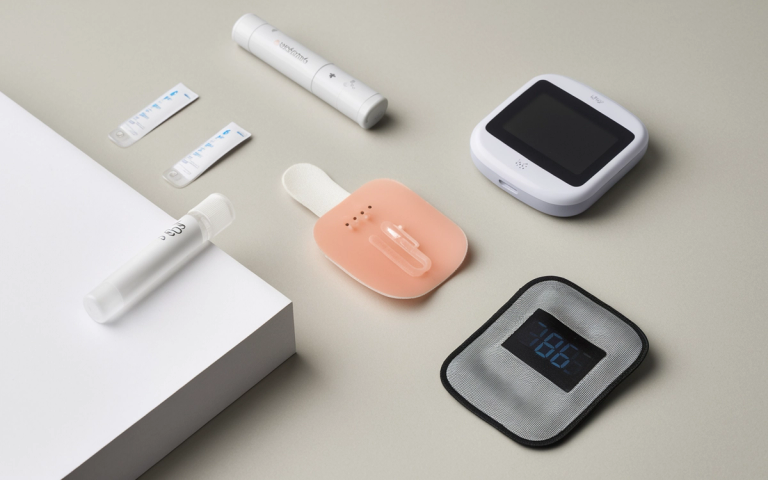What will home health tests look like over the next 10 years?
- Date:
- 04/04/2025
- Author:
- Ellie Jones

Home rapid health tests are transforming personal healthcare in today's world. With technology quickly advancing, at-home diagnostic tools are becoming more accurate and an accessible way to take control of your health.
We predict that in the next decade, we will see significant progress with in-home testing, making health management easier than ever.
They’ll cover everything from hormone tracking to chronic disease monitoring, all from the comfort of your home.
Here’s what’s on the horizon.
The evolution of at-home diagnostic tests
As many of us have likely experienced, diagnostic tests often require long waiting times and occasionally invasive procedures.
After the outbreak of the COVID-19 pandemic, it shed light on the need for rapid at-home testing, driving the development of more efficient and user-friendly diagnostic tools.
In the next few years, it appears that home health tests will expand beyond infectious diseases and will expand to a much broader range of health concerns, including hormone monitoring, nutritional deficiencies, and chronic disease management.
Here are our five predictions for future developments in the world of home rapid health testing.

1. The rise of saliva-based testing
One of the most ground-breaking advancements in home health testing is the shift towards saliva-based health testing.
As opposed to blood or urine samples, saliva collection is much less invasive, painless, and easy to perform.
It appears that companies are developing lateral flow immunoassay (LFIA) tests, using saliva to detect biomarkers for various conditions, including viral infections, hormonal imbalances, and even certain cancers.
With rapid results and high accuracy, these forms of tests are becoming increasingly common and will no doubt become a staple in home healthcare.
2. At-home hormone monitoring
Hormones play a key role in regulating the body, from metabolism and stress response to reproductive health. New technologies have emerged which allow people to track their hormone levels from home.
Devices that allow users to monitor cortisol and progesterone levels through a smartphone-connected device are already on the market. Further development of these and similar technologies is sure to grow what’s available.
These developments reveal just how convenient and adaptable home testing is becoming, with future developments likely to include testosterone, estradiol, and insulin tracking, helping people to better understand their bodies and the symptoms behind their conditions.
3. Smart health testing: AI-powered diagnostics
Another way in which the future of home rapid testing is predicted to change is through the incorporation of Artificial Intelligence into home health testing. Smart testing devices connected to mobile apps will not only provide instant results but also be able to analyse trends over time.
These AI insights will allow users to receive personalised health recommendations, early warnings for potential issues, and also remote consultations with healthcare professionals.
These online tools will allow individuals to take proactive steps in managing their health without frequent doctor visits.
It has been announced that certain AI technologies have received backing from the government’s Health Technology Adoption and Accelerator Fund, including a technology aiming to give patients control of their health at home by helping them monitor a range of conditions, including:
- Motor neurone disease
- Cancer
- Diabetes
- Frailty
- Respiratory diseases
These forms of AI have already started to be introduced throughout 2024 and give a glimpse of what developments are to come with the incorporation of artificial intelligence in home healthcare.
4. The future of home chronic disease testing
It appears that rapid health tests are not just suitable for identifying infectious diseases, but also for those who suffer from chronic conditions.
Future at-home tests will allow individuals to monitor conditions like:
- Diabetes – Blood sugar tracking with non-invasive glucose monitors
- Heart health – At-home cholesterol and blood pressure monitoring
- Vitamin and mineral deficiencies – Quick tests to detect iron, vitamin D, and B12 levels
One example of this can be found in the NHS trialling of at-home tests for the prevention of chronic kidney disease, with these devices potentially helping “detect 1,300 cases of undiagnosed chronic kidney disease.”
5. The role of digital health platforms

With greater advancements in connectivity, home test results will be able to seamlessly integrate with digital health platforms.
These platforms will store test data, analyse health trends, and provide recommendations based on AI-driven insights.
For example, smart devices linked to mobile apps will send alerts when test results indicate potential health concerns, prompting users to consult with healthcare professionals. This integration will bridge the gap between at-home testing and professional medical care.
Overcoming challenges: accuracy, regulation, and adoption
To be able to ease the expansion of AI and technology into at-home testing, companies are investing in more trials and user education to improve the usability of home diagnostic tools.
Some key elements of this involve:
- Monitoring accuracy and reliability – Ensuring home tests provide results as accurate as laboratory-based diagnostics.
- Regulatory approvals – Meeting tight medical guidelines for at-home use.
- Public awareness and adoption – Educating consumers on the benefits and proper use of certain home testing kits.
Impact on healthcare costs and accessibility
One of the most beneficial effects of the future rise of home health testing could be its improvement of healthcare costs and accessibility.
By providing individuals with tools to monitor their own health regularly, these tests could reduce the number of unnecessary doctor visits and emergency trips, having a profound effect on lowering healthcare costs and alleviating the burden on public services.
With affordable, user-friendly tests, more individuals will be able to take charge of their health, ensuring early detection and prevention at a fraction of the cost of traditional healthcare services.
What the future holds

When viewing all the exciting developments on the horizon, it appears that home health tests are becoming an integral part of daily wellness routines.
Some exciting tests in the pipeline include:
- Wearable diagnostic sensors – Continuous health monitoring through smart wearables.
- Breath-based testing – Non-invasive detection of diseases through breath analysis.
- DNA and microbiome testing – Personalized insights into genetic predispositions and gut health.
As these technologies develop, individuals will have unprecedented control over their health.
Mental health and lifestyle monitoring
Additionally, home tests could play a crucial role in mental health monitoring. Devices that track stress hormones like cortisol or mood-related biomarkers can help individuals manage mental health conditions much more effectively.
As mental health awareness grows, home testing can allow individuals to detect early signs of stress, anxiety, or depression, enabling them to take action with the support of healthcare professionals. These innovations will also empower people to make lifestyle changes tailored to their specific health needs.
With the ability to regularly check on vitamin levels, exercise progress, or sleep quality, users will have valuable insights to make better decisions around diet, fitness, and overall wellness.
In the future, home health testing will not just be about reacting to illness but about creating a culture of prevention, where individuals are equipped with the tools and knowledge to live healthier lives, reducing the overall burden on healthcare systems and improving quality of life.
The future of home health testing
Home rapid health tests are set to revolutionise personal healthcare over the next decade. With advancements in AI, saliva-based diagnostics, hormone tracking, and chronic disease monitoring, at-home testing will become more accurate, accessible, and integrated with digital health platforms.
By embracing these innovations, individuals will gain greater control over their well-being, reducing reliance on traditional healthcare systems while ensuring early detection and prevention of diseases.
As technology continues to evolve, one thing is clear: the future of home health testing is bright, and it’s happening faster than ever before.
ProductsProducts featured in this blog
View all kits
- Bundles
- At-home tests
Home Underactive Thyroid (TSH) Rapid Test Kit
£10.00£12.00

